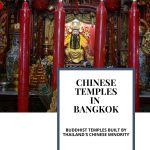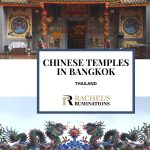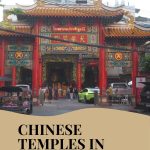Chinese Temples in Bangkok
When I wrote my article about the best temples in Bangkok, I purposely left the Chinese temples off the list. Why? Because while the religion is the same – Buddhism – the temples are in a very different architectural style.
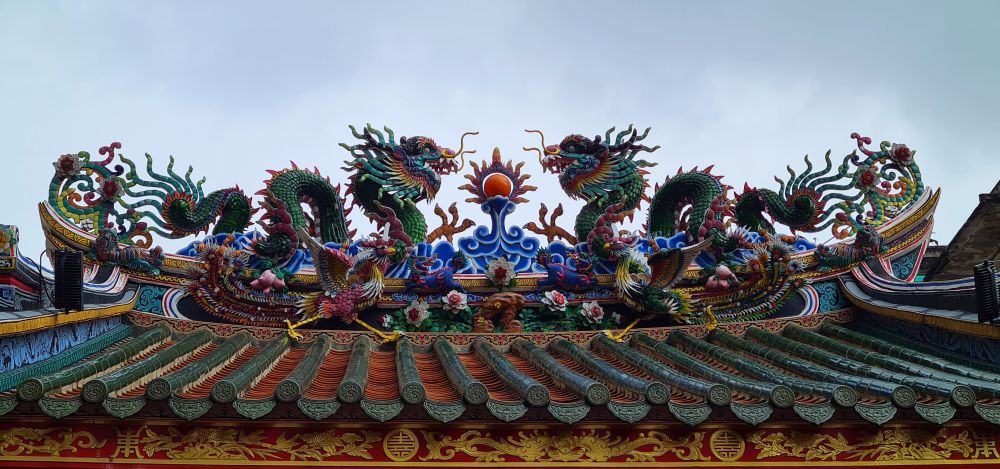
If you’ve ever been to Bangkok, you likely visited Bangkok’s Chinatown. Thailand’s largest minority group is Chinese: more than 10% of the population. They’re mostly second or third generation and speak Thai, and there’s been a lot of intermarrying, which is why it’s hard to know exactly how many there are; it depends how you count.
Disclosure: This article contains affiliate links. If you click on one of them and make a purchase, I will receive a small commission. This will not affect your price.
The Chinese, historically speaking, are Mahayana Buddhist. Apparently, many have assimilated to Theravada Buddhism, which is what the vast majority of Thais follow. While some are Mahayana and some are Theraveda, the Chinese temples often have images of Taoist or other deities from Chinese religions along with Buddha images.

So anyway, the city of Bangkok is home to quite a few Chinese-style temples built by Chinese immigrants. Thai temples, as I described in my other article, are generally large complexes with many buildings – beautiful architecture with their Thai-style swooping roof lines – and usually include high stupas. By contrast, the Chinese-style temples are smaller, generally just one building and maybe an outbuilding or two. They don’t have tall stupas, and they’re extremely colorful, both inside and out.
What follows is a list of the best Chinese temples in Bangkok, as well as my recommendations for which ones are “must-see” temples.
I’ve marked all of the places mentioned in this article on the Google map below. The places that are not Chinese temples – which I’ve added to help you plan your sightseeing – are in black.
Best Chinese temples in Bangkok
Two parts of historic Chinatown are where the temples mostly cluster: Talat Noi is the lesser known of the two; the part that is more touristy is called Yaowarat.
Chinatown Heritage Center at Wat Traimit
Before I move to my list, I just want to point out Wat Traimit, which is right between Talat Noi and Yaowarat. I included Wat Traimit in my earlier post about the 13 best temples in Bangkok because it is, in its architectural design, more a Thai temple than a Chinese one. It’s also the temple of the Golden Buddha. Nevertheless, it is Chinese in that it houses the Chinatown Heritage Center. Click this link to read the section of that article about Wat Traimit.
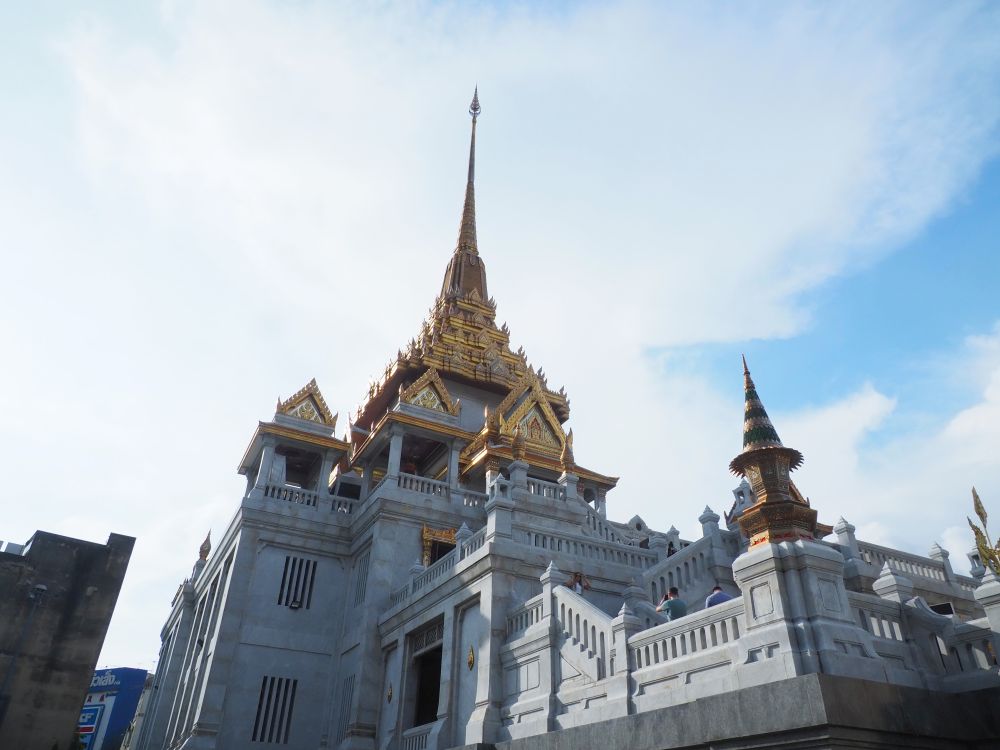
I should also point out that this list is not exhaustive, but my goal is to point out the Chinese temples in Bangkok that you’re most likely to happen upon and the ones you really should make an effort to visit.
Yaowarat Chinese temples
Wat Bamphen Cin Phrot
This Mahayana Buddhist temple is purported to be among the oldest temples in Bangkok and also one of the smallest Chinese temples in Thailand. It occupies a single old shophouse right on Yaorawat Road, Chinatown’s main road. Originally established in the late 1700s, it was abandoned and then fixed up in the mid-1800s.
The main altar holds three Buddha images, known as the Trikaya, a concept from Mahayana Buddhism in which the Buddha has three bodies, or rather three images represent three aspects of the Buddha. The Dharmakaya represents the reality of the Buddha: its true nature that is inconceivable. The Sambhogakaya represents the divine incarnation of the Buddha: its form that allows teaching and that is limitless. The Nirmanakaya represents the physical incarnation of the Buddha. If I understand it correctly, the first of the three is the true Buddha, while the Sambhogakaya and the Nurmanakaya are manifestations of the Dharmakaya to aid in teaching and comprehension.
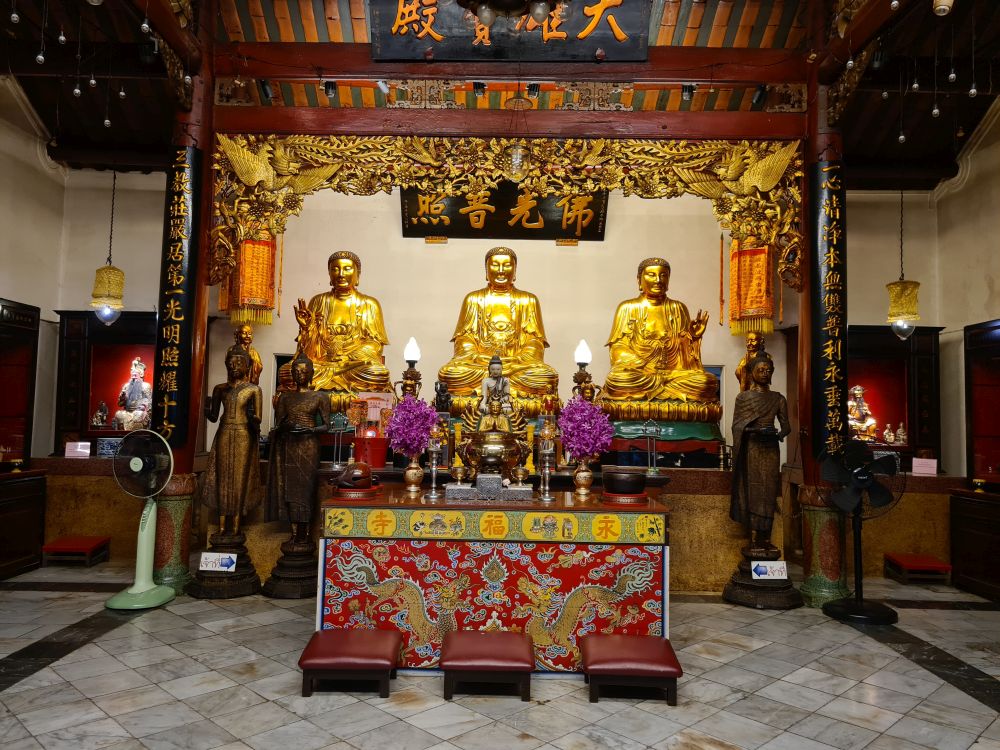
There are more statues on the sides representing the 18 arhats (monks who were followers of the Buddha and reached nirvana) and various Chinese gods.
Wat Kanma Tuyaram
This is a rather surprising temple since it’s in a busy shopping district and its ornate entrance gate really stands out among the more utilitarian buildings around it. It’s a Theravada Buddhist temple, and much more in Thai style than others on this list, with typical Thai architecture. A small stupa next to the ordination hall is unusual in that it’s a copy of one in India.
Dating to 1864, Wat Kanma Tuyaram was built by a wealthy Thai-Chinese family whose money came from a brothel business. They financed this and other temples in an attempt to atone, but also to improve the family’s reputation.
The main attraction here is the ornately-carved entrance gateway which is, unfortunately, obscured by the tangles of wire that seem to be a feature all over Bangkok.
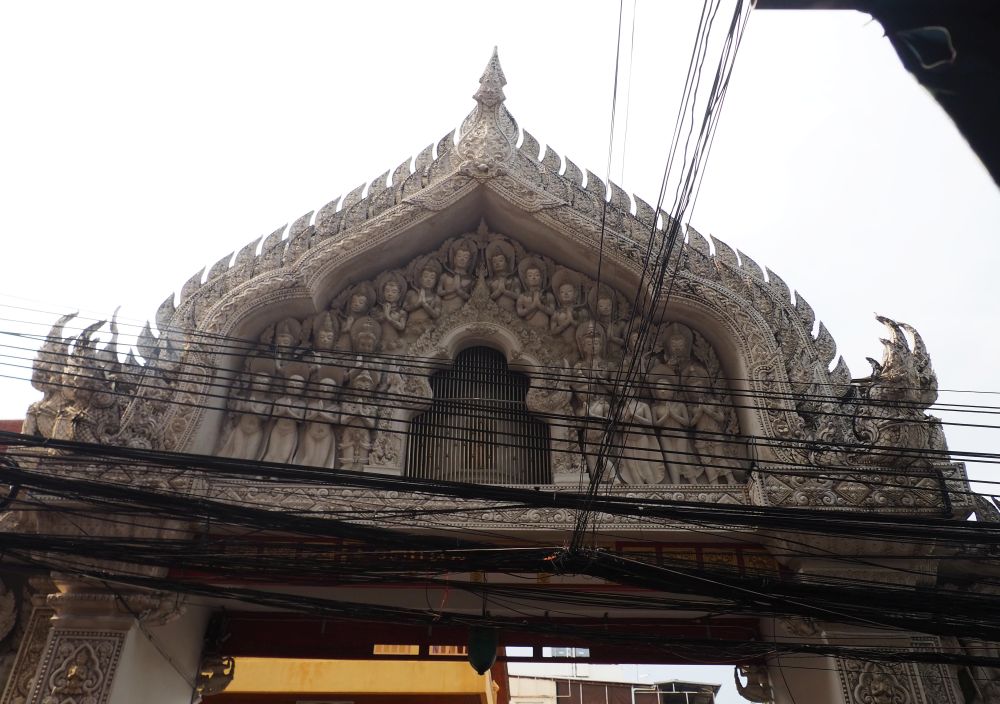
Leng Buai La
Leng Buai La is possibly the oldest Chinese temple in Thailand; a sign outside gives a date of 1658. It’s a classic Chinese temple, with wonderful dragons curling around the pillars in front, along the roof peak, and up free-standing poles in the small courtyard. It presents quite a contrast to the rather grim apartment buildings on three sides and the overgrown ruin on one side.
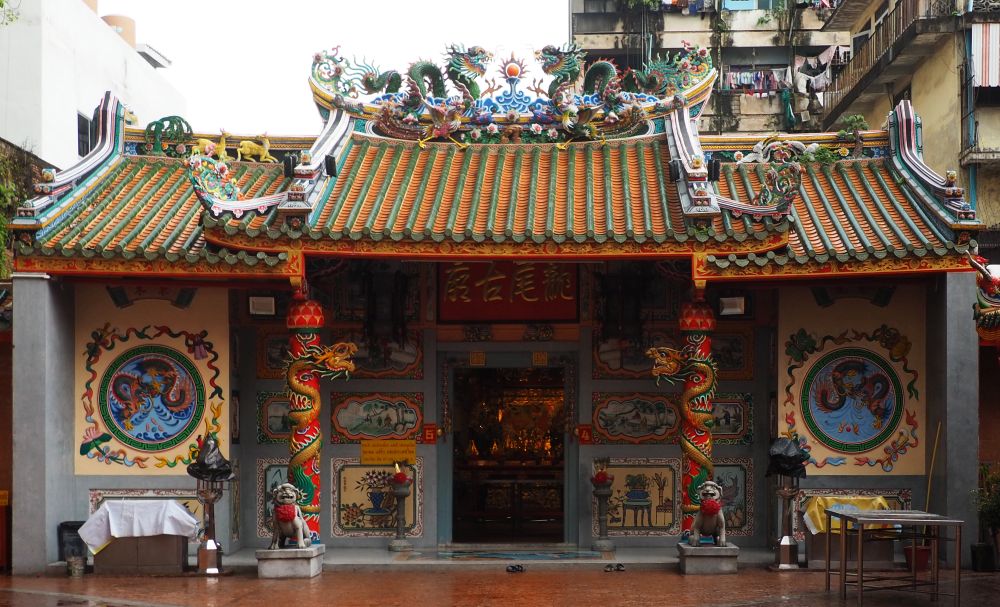
Inside, notice the colorful bas-relief tiger on one side and dragon on the other, each topping a pretty fountain. The figures in the central altar are Leng Buai La and his wife (though I’m not sure who they are). On the left is Guan-Wu (or Guan Yu) who is a deified version of a general in the Eastern Han dynasty (about 200 AD) in China. The goddess of seafaring is on the right, which would have been a fitting choice because the Chinese merchants who worshipped here worked in maritime businesses.
Wat Mangkon Kamalawat
Very near to Leng Buai La is Wat Mangkon Kamalawat, the largest and much better-known Buddhist temple in Bangkok. A Mahayana Buddhist temple, it was established in the 1870s. It has a number of different rooms and a range of shrines, all with ceilings hung with red paper lanterns. The temple was under renovation when I was there, but from an inner courtyard I could still see the beautiful workmanship on the building itself. Perhaps because it’s right in the center of Chinatown in the heart of Bangkok, this seems quite a popular temple.
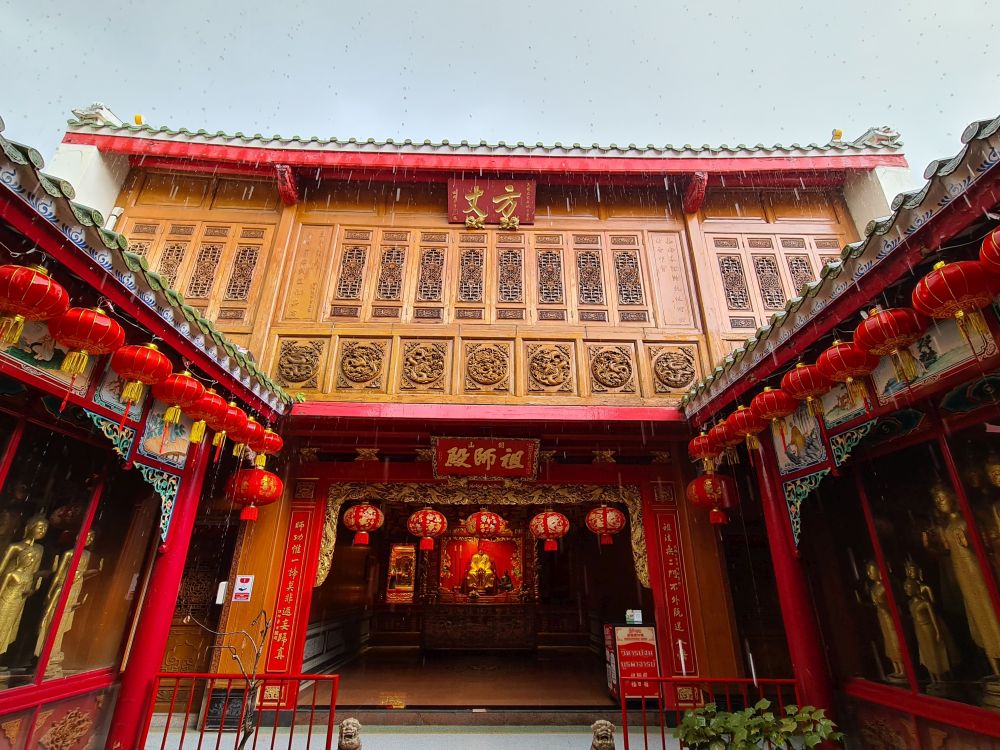
In the main entrance, you can’t help but notice four huge (4 meters/13 feet) and fierce-looking statues behind glass. These are the Four Heavenly Kings a.k.a. Four Guardians of the World: gods who watch over the four points of the compass. There’s also a charming laughing Buddha statue, which is apparently based on a wandering monk from the 10th century who came to be venerated in China after his death.
The main altar holds three Buddha statues, portraying three manifestations of the Buddha, like at Wat Bamphen Cin Phrot temple.
You’ll see a huge number of gold-painted figures in cases: Buddha images, many of them in a pose called the Abhaya Mudra. It represents fearlessness and protection, but these are unusual figures because they show a double Abhaya Mudra, using both hands instead of just one.
Thai-style temples not too far away
If you are in Yaowarat at any of this cluster of Chinese-style temples (Wat Mangkon Kamalawat, Wat Bamphen Chin Phrot, Wat Kanma Tuyaram and Leng Buai La), you’re only a short taxi or tuk-tuk distance from several Thai-style temples worth seeing: Golden Mount temple (Wat Saket) especially, and if you’re going there you could then walk to Wat Thepthidaram and Wat Ratchanatdaram (Metal Palace).
In a different direction, you could take a short taxi or tuk-tuk ride to the grounds of the Grand Palace complex and see Wat Mahathat and the Temple of the Emerald Buddha, an especially impressive temple).
Talat Noi
Hon Wong Kung temple
In the Talat Noi neighborhood in Bangkok Chinatown, you can find the Hon Wong Kung temple, a Hakka shrine. The original temple nearby was older, but the current temple building was completed in 1888. The main statue is not a Buddha, but a bearded figure called San Chao Rong Kueak, which is why this is also called San Chao Rong Kueak temple. It depicts a deified Emperor Gaozu, the first emperor of the Han dynasty.
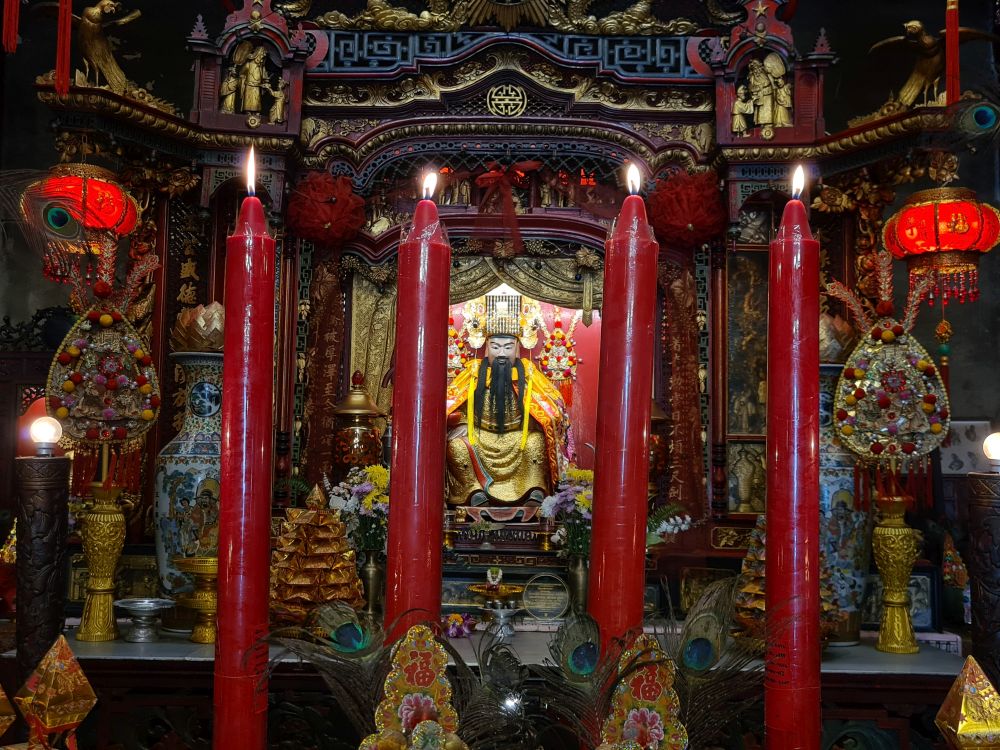
Notice the detail on this temple: the carvings on the roof outside, for example, and the intricacy of the delicate tracery of the central altar inside. By contrast, the ceiling and walls inside are rather bare and in poor repair. Is that to keep worshippers’ attention on the shrines?
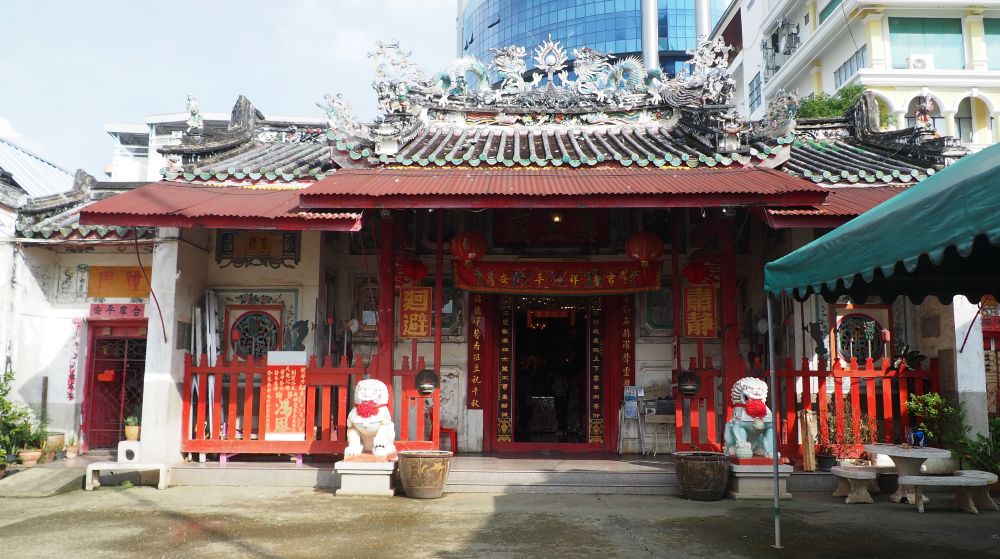
Marine Department is the nearest ferry stop. While you’re right nearby, visit the Holy Rosary Church as well. Also known as Kalawar Church, it is a Portuguese Catholic Church. Like Hon Wong Kung, the original church was older – King Rama I gave the Portuguese the land in 1786 – but the current building is neo-Gothic, dating from the late 1800s.
Bann So Heng Tai (a side trip)
While you’re in Talat Noi, check out Bann So Heng Tai as well. This rundown former mansion around a courtyard dates to the early 19th century, when it was built by a dealer in birds’ nests. It’s still in the hands of his descendants, who live on the ground floor but allow visitors to wander some of the upper floor for the price of a drink in their little café.
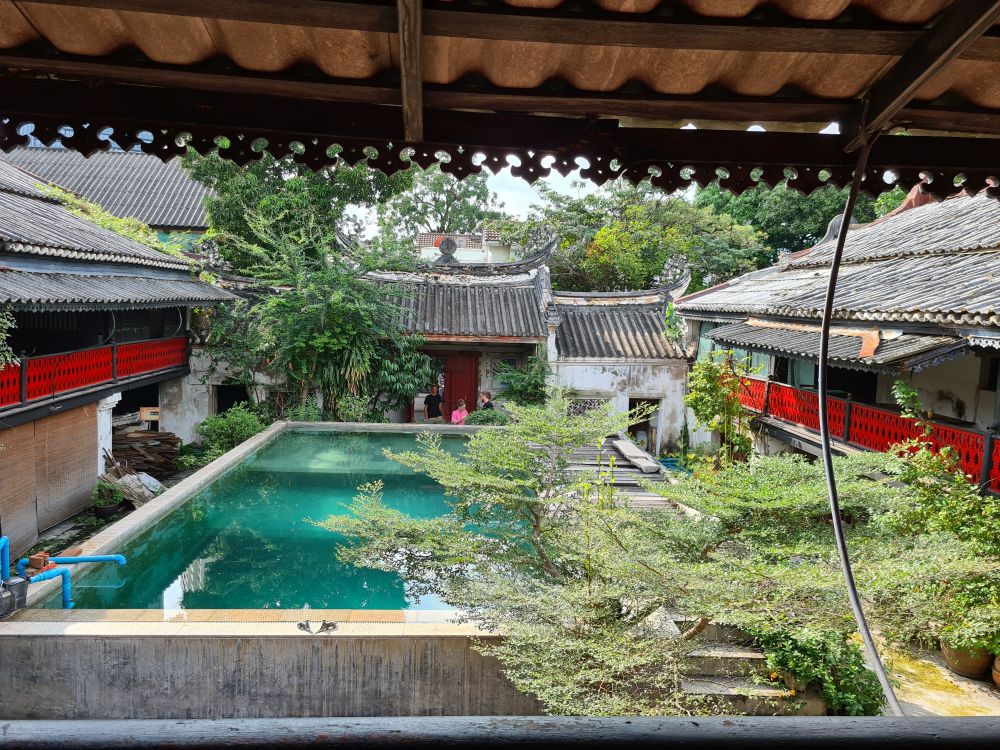
The architecture is a combination of Thai and Hokkien Chinese styles, with the upper floor finely carved in teak. While it’s seriously decaying – some of the back rooms have collapsed – you can still get an inkling of how a prosperous family of the 1800s lived, with their wide balconies and ornate entrance gate. A swimming pool fills the large courtyard, which the family uses for a diving school.
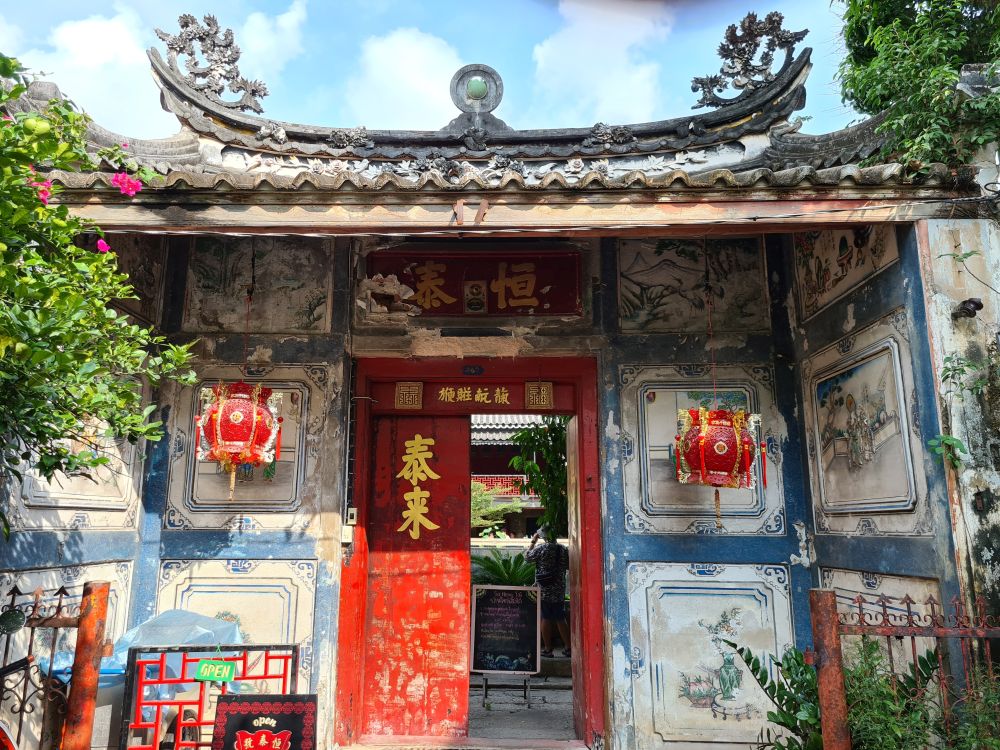
This 4-hour Chinatown guided tour will give you an overview of the history of Bangkok’s Chinatown and includes Wat Mangkon Kamalawat and Bann So Heng Tai, as well as touring through both Talat Noi and Yaowarat.
Sri Maha Mariamman Temple (another side trip)
Not too far away if you take a taxi or tuk-tuk, you can find a very different sort of temple: Sri Maha Mariamman, a Hindu temple. Like the Chinese Buddhist temples, it’s small scale and highly decorated. In this case the carvings portray a range of Hindu gods.
This Indian Hindu temple dates to 1879, built by and for immigrants from Tamil Nadu, and it’s the most important of Bangkok’s Hindu temples. Inside are three main shrines dedicated to Ganesh, Kartik and Mariamman, but many other gods are represented as well. Photography is not permitted inside the temple grounds.
When I visited this beautiful temple, I noticed that some of the people worshipping inside or just outside the temple on the sidewalk did not appear to be of Indian ancestry. I asked one man, after he finished praying and started on his way, whether he was Hindu. His response: “It’s all the same.” This echoes something I sensed at many temples, both Thai and Chinese: whether a temple was built by Chinese immigrants or Thais or, in this case, Indians, doesn’t matter to the person who worships, nor does it matter whether the Buddha, various gods or both are depicted. Anyone can pray at a Chinese Buddhist temple, a Thai Buddhist temple, or an Indian Hindu temple, and they do.
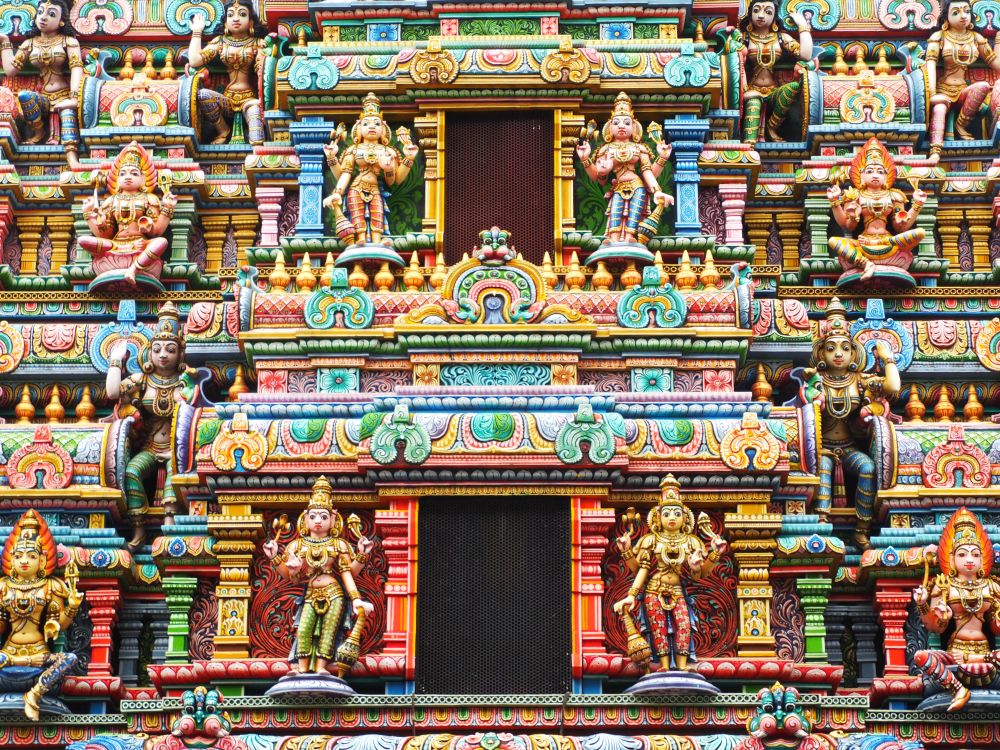
Other Chinese shrines in Bangkok
Kian An Keng
This Hokkien temple is the only one on this list that’s on the Thonburi side of the Chao Phraya River. That’s because it dates to the period (1767-1782) when the capital of Thailand was on this side, called Thonburi. Or rather, the two earlier temples on the site dated to the Thonburi period. The current one is newer.
While the courtyard in front is fairly large, the temple itself is very small. The main image is of Guanyin, the goddess of compassion or mercy.
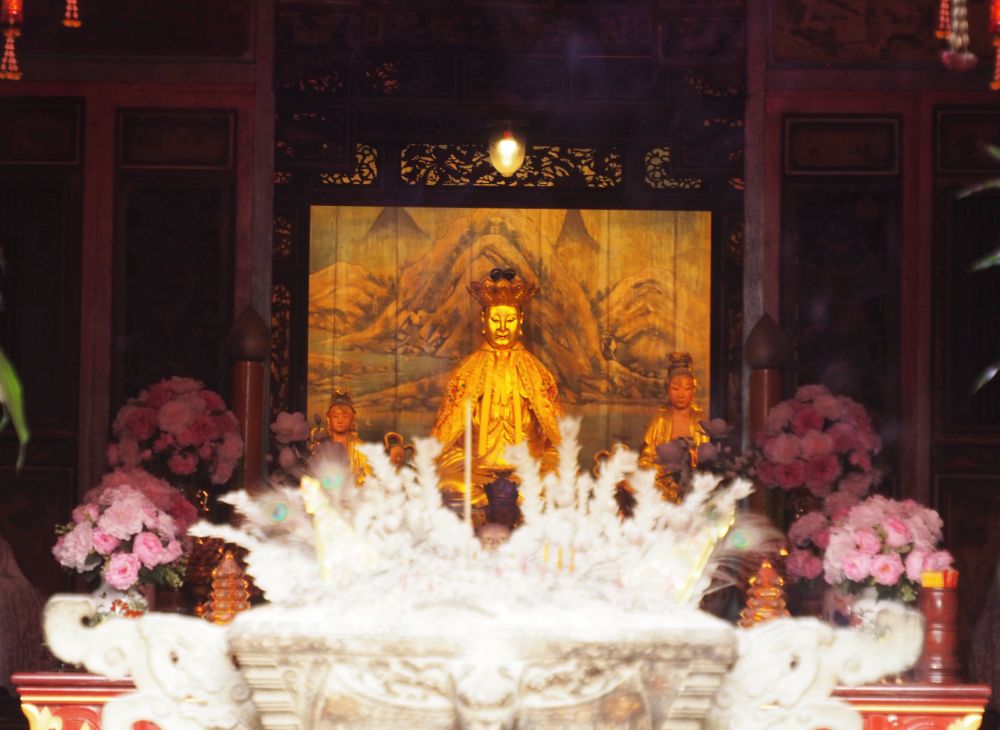
It’s a charming little temple in classic Chinese architectural style, with carvings along the roof peaks. The walls both inside and outside are painted. Inside they don’t depict the Buddha’s life, as you’d expect, but scenes from the classical Chinese novel Romance of the Three Kingdoms, which Guan Yin features in. I found the pictures difficult to make out, though, partly due to the low light in the temple, but also because they’re quite brown from the smoke of the incense and candles that worshippers burn there.
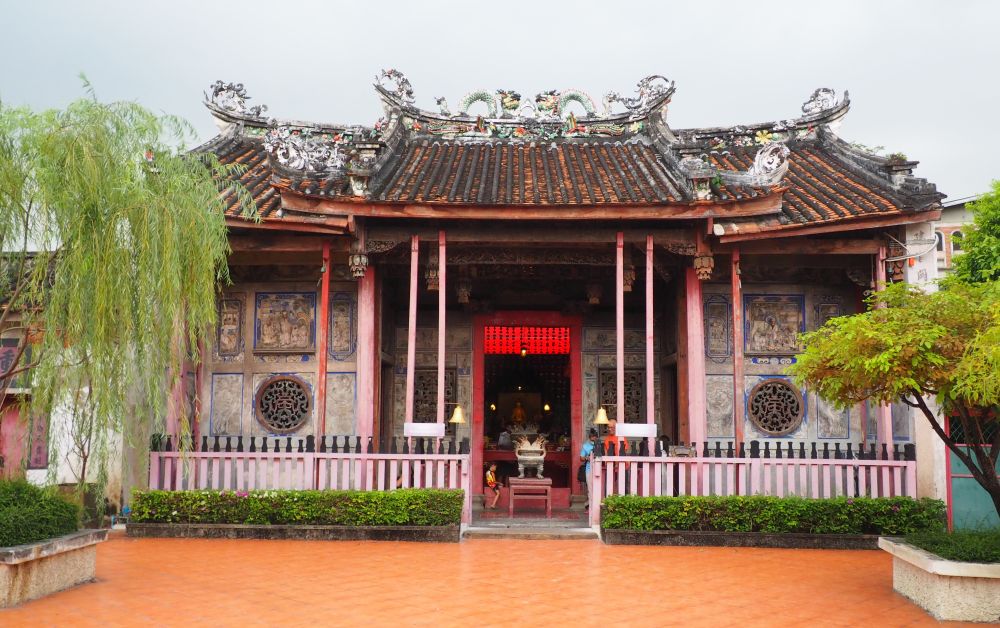
This temple is quite close to the river, and at least when I was there it was very evident that the sea level rise is an issue. The entrance on the river side was filled in with sandbags that visitors had to walk over. The walkway on stilts that used to continue south past the temple just ends there, a few lonely stilts leaning here and there.
Note added in January 2024: I went back to this temple today, and it’s going through some refurbishments, though I’m not sure how much they’ll do. In the meantime, the walkway has been considerably upgraded. It’s not wooden anymore, and continues quite a ways further south, making it far easier to visit Santa Cruz Church and Wat Prayun – see my post about the Thai temples in Bangkok to read about those.
Sights near Kian An Keng
The nearest ferry pier is Wat Kalayanamit. While you’re practically next door, you might as well visit Wat Kalaya as well since it’s not far away on the west bank of the Chao Phraya River; it’s a very pretty Thai-style temple complex. Also the Santa Cruz church (a Portuguese Catholic church) is just a short way away in the other direction.
It’s just a short taxi ride or a longish walk from here more or less south to several of the Thai-style temples: Wat Prayoon, Wat Anong and Wat Phitchaya. In the other direction, I’d recommend even more highly that you visit Wat Arun, also known as the Temple of Dawn: it’s the next ferry stop on this side of the river going north, and it’s an exceptionally beautiful Thai-style temple.
Kuan Yim Shrine
This temple is right near Wat Traimit and about halfway between Yaorawat and Talat Noi. What’s unusual about it is that it is on the grounds of the Thian Fah Foundation Hospital. It was founded early in the 1900s to provide free care to poor Chinese immigrants and offers both Western and Chinese medicine to this day.
The shrine was built at the same time as the hospital so that patients and their families could worship nearby. It’s an impossibly colorful affair, mostly in the open air, the walls covered in bright murals. It seems to be a very popular place.
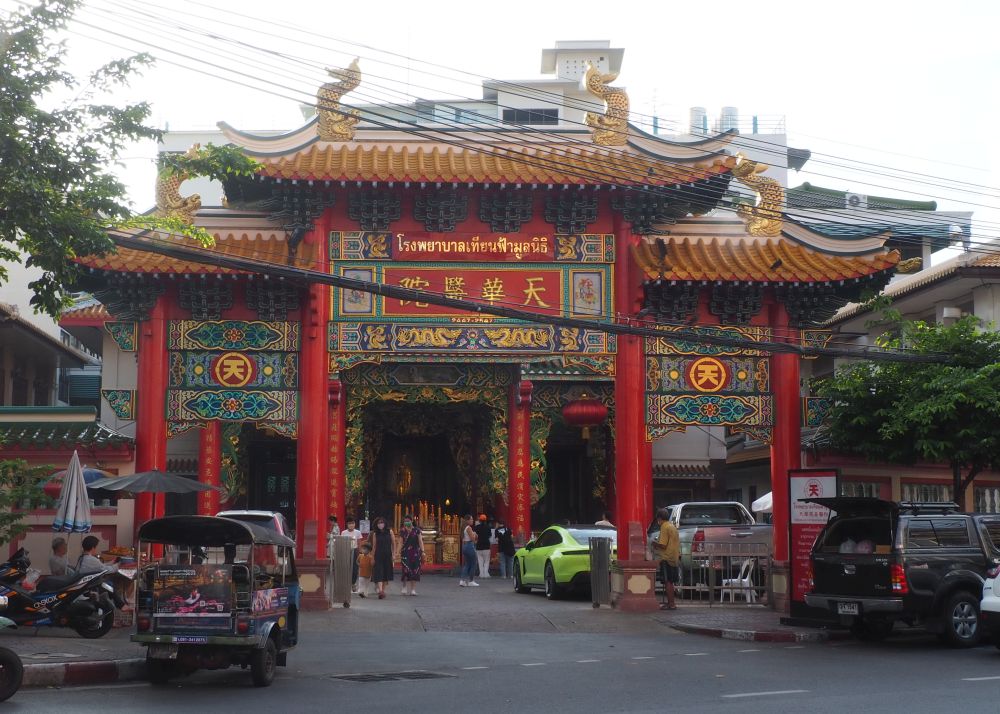
Like Kian An Keng temple, described above, this is a Guan Yin shrine, dedicated to the goddess of mercy. The statue depicting her is purported to be 900 years old, brought here from China as recently as the 1950s. Made of teak, it’s painted a shiny gold leaf.
Where I stayed in Bangkok
On my visit to Bangkok, several Holiday Inn hotels sponsored my stay: Holiday Inn Bangkok Sukhumvit, Holiday Inn Express Siam, and Holiday Inn Express Sathorn. I was happy with all of them. You can read my thoughts on the 10 Bangkok hotels I’ve stayed in here.
If none of those suit you or they don’t have a room available, use this link to book other accommodations in Bangkok.
Which Chinese temples should you see in Bangkok?
I would say that you should start with Wat Traimit so you have an understanding of Chinese history in Thailand. Then decide whether you’re going to head to the Yaowarat part of Chinatown or the Talat Noi neighborhood. If you’re going to be in Yaowarat – which is likely if you intend to enjoy any Chinese street food – definitely see Wat Mangkon Kamalawat, and since it’s so nearby, see Leng Buai La too. Those are the two most impressive temples from this list.
If you are going to be in the Talat Noi neighborhood, the Hon Wong Kung temple is smaller and not in as good repair as Wat Mangkon Kamalawat or Leng Buai La, but it’s got a certain homey charm. And you might as well see Bann So Heng Tai mansion while you’re there. The area is also good for getting a glimpse of a more authentic Bangkok, with very narrow streets and old-style housing. Watch out for motorbikes, but also keep your eyes open for some interesting street art!
It’s far away from the others, but I also really liked Kian An Keng. It’s small and quiet and rough around the edges, but it’s a serene place in a very busy city. Much like the area around Hon Wong Kung temple, you can get a sense of non-touristed Bangkok on the side streets near here. If you’re in the neighborhood, perhaps to visit Wat Kalaya, stop in here as well.
I wasn’t there at the right time, but it seems to me that the Chinese New Year would be the very best time to visit Bangkok and take in at least a few of these temples. They’ll surely be a hive of activity then!
If you have visited any Chinese temples in Bangkok, whether they’re on this list or not, please add a comment below!
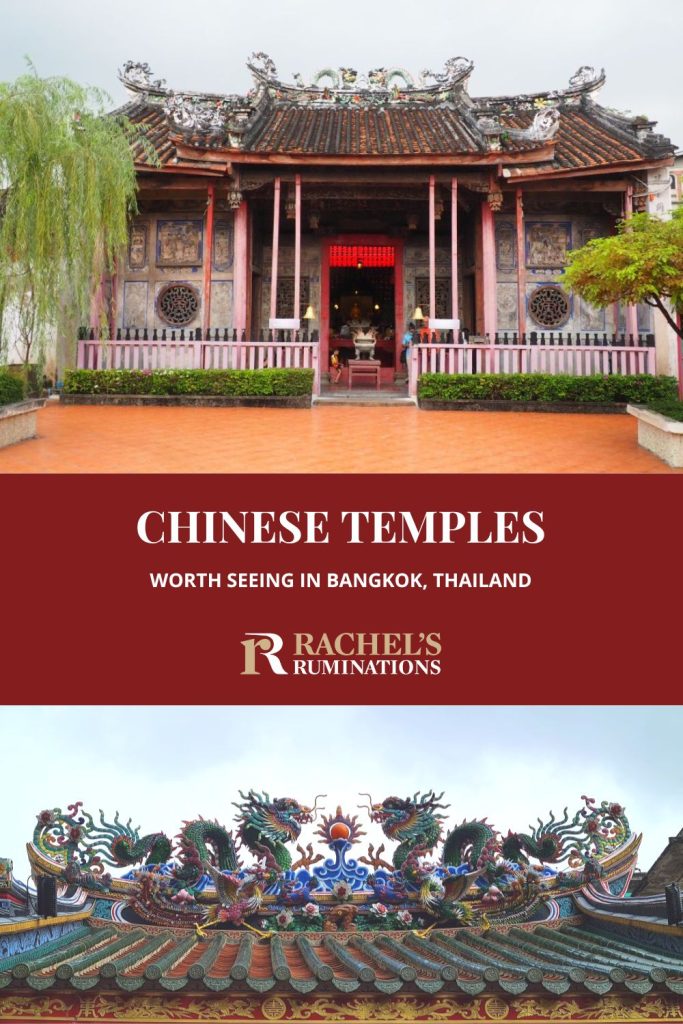
My travel recommendations
Planning travel
- Skyscanner is where I always start my flight searches.
- Booking.com is the company I use most for finding accommodations. If you prefer, Expedia offers more or less the same.
- Discover Cars offers an easy way to compare prices from all of the major car-rental companies in one place.
- Use Viator or GetYourGuide to find walking tours, day tours, airport pickups, city cards, tickets and whatever else you need at your destination.
- Bookmundi is great when you’re looking for a longer tour of a few days to a few weeks, private or with a group, pretty much anywhere in the world. Lots of different tour companies list their tours here, so you can comparison shop.
- GetTransfer is the place to book your airport-to-hotel transfers (and vice-versa). It’s so reassuring to have this all set up and paid for ahead of time, rather than having to make decisions after a long, tiring flight!
- Buy a GoCity Pass when you’re planning to do a lot of sightseeing on a city trip. It can save you a lot on admissions to museums and other attractions in big cities like New York and Amsterdam.
- Ferryhopper is a convenient way to book ferries ahead of time. They cover ferry bookings in 33 different countries at last count.
Other travel-related items
- It’s really awkward to have to rely on WIFI when you travel overseas. I’ve tried several e-sim cards, and GigSky’s e-sim was the one that was easiest to activate and use. You buy it through their app and activate it when you need it. Use the code RACHEL10 to get a 10% discount!
- Another option I just recently tried for the first time is a portable wifi modem by WifiCandy. It supports up to 8 devices and you just carry it along in your pocket or bag! If you’re traveling with a family or group, it might end up cheaper to use than an e-sim. Use the code RACHELSRUMINATIONS for a 10% discount.
- I’m a fan of SCOTTeVEST’s jackets and vests because when I wear one, I don’t have to carry a handbag. I feel like all my stuff is safer when I travel because it’s in inside pockets close to my body.
- I use ExpressVPN on my phone and laptop when I travel. It keeps me safe from hackers when I use public or hotel wifi.


